Primary navigation
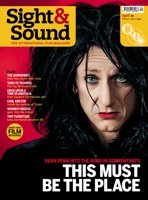

The Hand
Born 100 years ago, the Czech artist Jirí Trnka spent his career bringing fairytales magically to life, in book illustrations and puppet animation – until his last film turned his talents to a devastating allegory of Stalinism. Peter Hames surveys his career
The West Bohemian capital of Plzen (Pilsen) has a statue commemorating two puppet figures – Spejbl and his son Hurvínek. Created by Czech puppeteer Josef Skupa in the mid-1920s, they achieved a legendary status, and repertory performances continue to this day. In 1930 one of Skupa’s most gifted students, the 18-year-old Jirí Trnka, helped create two additions – Mánicka, the girl next door, and the pet dog Zeryk.
In the 1950s, Trnka was to become the dominant influence in Czech film animation. In fact he’s been as described in a recent study as one of the foremost Czech artists of the 20th century, in any medium. Like a rather different Czech animator, Jan Svankmajer, Trnka’s work transcends any one medium – he was puppet-maker and puppet-master, painter, graphic artist, sculptor, stage and costume designer. It’s perhaps this ‘total vision’ that gives his work its own unique flavour and sensibility – a sense that his illustrations, with their lyrical use of landscape, have been given life.
Born 100 years ago this February into a lower-middle-class family still aware of their rural background, Trnka showed an early facility in drawing and wood carving. As a child, he created his own marionettes and staged performances for his friends. After studying under Skupa, he was trained at Prague’s Academy of Art and International Design, graduating in 1935. He began his career with newspaper cartoons and illustrations, but was soon renowned for his book illustrations (principally fairytales), illustrating 130 books during his lifetime. In 1936 he founded his own puppet theatre, moving on to work as a stage and costume designer in the 1940s. Here he developed his skill as a painter before moving to film animation when he was invited to join the Trick Brothers (Bratri v triku) studio in 1945.
During the 1950s, at the height of the Stalinist repression in Czechoslovakia, it was animated cinema that attracted world attention. In a career stretching 20 years, from the mid-1940s to the mid-1960s, Trnka made as many films, including six features. At the same time the other great Czech animation director of the era, Karel Zeman, was also attracting attention with his Méliès-influenced mixture of live action and animation (he had earlier studied in Paris as an advertising artist). It’s easy to see why the Czech approach to animation came to be seen as a refreshing alternative to Disney, their films shown internationally both in cinemas and on television.
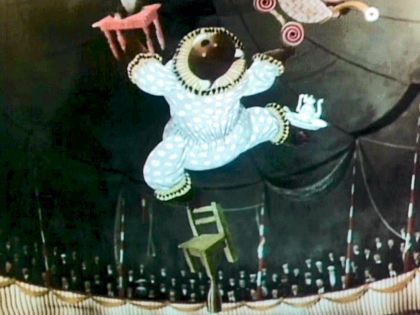
The Merry Circus
Trnka’s early work is in what some might see as the more conventional area of two-dimensional animation, but his film The Gift (Dárek, 1946) was hailed by John Halas and Joy Batchelor in the Penguin Film Review for its “pure sense of graphic design”. One French critic even described it as the Citizen Kane of animation. Stephen Bosustow of UPA – makers of Mister Magoo and the award-winning Rooty Toot Toot (1951) – admitted its effect on their new styles of animation, and there was also an obvious influence on the conventions of the Zagreb school of animated films.
Of course, modernist inclinations were not encouraged in Czechoslovakia after the imposition of Socialist Realist ideas following the Communist takeover of 1948. Nonetheless Trnka is often credited with having kept the more experimental traditions of Czech art alive under conditions that were at best unpromising. His film The Merry Circus (Vesely cirkus, 1951), for instance, animated the images of the painter Frantisek Tichy, whose work was branded ‘formalist’ in the same year. While Trnka’s films frequently displeased the authorities, animated film was difficult for them to supervise, and he was working predominantly in the officially approved areas of folktale and fairytale.
His first puppet feature The Czech Year (Spalícek, 1947) was firmly embedded in the folk tradition, as was the later Old Czech Legends (Staré povesti ceské, 1953). In the first film, which consists of six episodes illustrating the customs and rituals of country life, Trnka’s puppets resemble products of a child’s imagination, with simple doll-like faces and short, fat bodies. The second film (adapted from Alois Jirásek’s collection of Czech chronicles and legends) moved towards greater individual characterisation – and was also the first in which Trnka’s puppets speak. Trnka began to be talked about as a ‘peasant poet’, with French critics comparing his work to the paintings of Henri ‘le Douanier’ Rousseau.
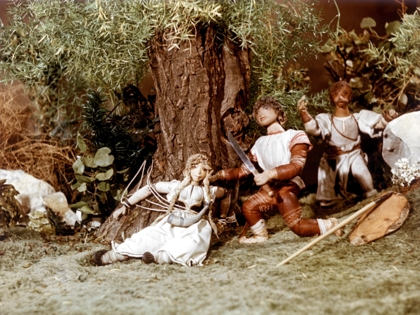
Old Czech Legends
Most accounts of Trnka’s work tend to focus on the development and design of his puppets, and the technical complexities of his work. Trnka found conventional cartoons limiting, arguing that the very nature of cartoon figures lies in continual motion – it’s not possible to stop them “or bring them into a state of contemplation”.
In the design of his puppets, by contrast, Trnka avoided the changing mouths and eyes of existing film tradition in favour of carefully painted fixed expressions. One of Trnka’s most important animators, Bretislav Pojar, noted that when Trnka painted his puppets, he gave them a deliberately undefined look – it was through movement and lighting that their characters and emotions would be revealed: “By merely turning their heads, or by a change in lighting, they gained smiling or unhappy or dreamy expressions.” In the grace and precision of movement, Trnka’s work often approaches an almost ballet-like aesthetic. The essence of his work can perhaps be said to rest in the ‘less is more’ approach advocated by his mentor Skupa.
Via his many book illustrations, Trnka made a significant contribution to the art of the fairytale, and he brought the same flowing lyricism to films such as his Hans Christian Andersen adaptation The Emperor’s Nightingale (Císaruv slavík, 1948), which won him international acclaim. Here he juxtaposes the live-action story of a sick boy with that of the Chinese emperor imprisoned in his palace. Reality interacts with fantasy as the various objects in the boy’s room are transferred to the world of puppets. Originally filmed without commentary, it was supplied with one for its French release by no less a figure than Jean Cocteau (and by Boris Karloff in the US).
In 1950’s Prince Bayaya (Bajaja), Trnka’s magical telling of a story of knights, princesses and three-headed dragons recalls the delicacy of Lotte Reiniger’s 1926 film The Adventures of Prince Achmed. His puppets are still like children’s toys, but they’re filmed with a delicate lyricism, all set to a stunning music score by Václav Trojan, including songs to verses by the one-time surrealist poet Vítezslav Nezval, author of Valerie and Her Week of Wonders (itself memorably filmed in 1970 by Jaromil Jires). The fluttering of Bayaya’s cloak and the delicate mane of his snow-white horse are important elements in the overall conception. In fact, Trnka always admitted that he strove for “lyrical expression”.
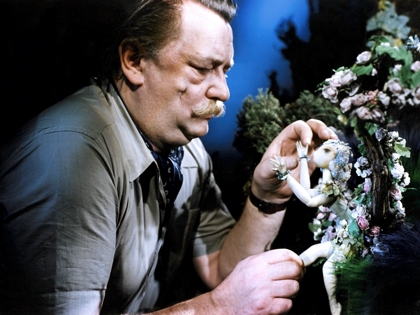
Trnka animating A Midsummer Night’s Dream
His crowning achievement in the fairytale genre, however, was his 1959 ’Scope feature version of A Midsummer Night’s Dream (Sen noci svatojánské), the narration of which was provided in English by Richard Burton. Here the three worlds of the Athenian court, the mechanicals and Oberon’s forest are presented in differing styles. Puck is magically transformed into bird or animal, and Titania’s train is a wonderful mass of flowers and insect-like fairies and elves. Drawing on both dance and pantomime, Trnka also uses a full range of ‘normal’ film techniques – long shots, close shots, a variety of angles and a moving camera. He further develops complex group scenes where the puppets ‘react’ as if on stage. Trnka had illustrated the play in the early 1930s and is unsurprisingly at his best in evoking the magic world of the fairies.
But if Trnka is best recognised for his folk- and fairytale-inspired work, his films embraced many other areas. His parody western Song of the Prairie (Arie prérie, 1949), based on Jirí Brdecka’s ‘Lemonade Joe’ western stories of the 1940s, was an international success, with its theme tune (later immortalised in the 1964 feature spoof Lemonade Joe/Limonádovy Joe) a parody of that for John Ford’s Stagecoach. Trnka’s adaptation of Jaroslav Hasek’s The Good Soldier Svejk (Osudy dobrého vojáka Svejka, 1954-55), meanwhile, provided a superb opportunity to satirise authority. Novel with a Double Bass (Román s basou, 1949) was adapted from Chekhov, while Cybernetic Grandmother (Kybernetická babicka, 1962) gave him a chance to develop in more formally radical directions.
Not by any means a political filmmaker, Trnka was immersed in a Czech tradition that tapped deeper roots than those of post-war radicalism. But his last film, the short The Hand (Ruka, 1965), was something new. It tells the story of a happy potter whose simple creative life is ruined by the demands of the state. An enormous hand commissions him to make official works, but he refuses. Initially the hand tries to persuade him, offering him money and women; ultimately it resorts to force. After being locked in a golden cage, the potter manages to escape and return to his humble craft. But his attempts to resist sculpting images of the monumental hand lead to terrifying hammerings at the door – and his eventual death from a heart attack. The state nonetheless places a medal on his coffin before ending with a fascist salute.
Appearing just after the first films of the Czech New Wave, but well before any of their explicitly political works, The Hand remains one of the most overt attacks on Stalinism to have been made in the 1960s. When Trnka died in 1969, the year after the Russian invasion of Czechoslovakia, he was awarded a state funeral. But when a retrospective of his work was held a year later at the Karlovy Vary Film Festival, The Hand was omitted. As late as the 1980s, an exhibit featuring The Hand even mysteriously disappeared from a 1980s Prague exhibition on the history of cinema.
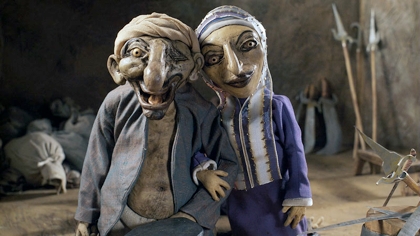
Fimfárum 2, co-directed by Trnka’s former assistant Bretislav Pojar
Trnka was undoubtedly the true founder of Czech puppet film – although his reputation as ‘the Czech Disney’ presents a false parallel. Given the extraordinary history of Czech and Slovak animated film since Trnka’s debut in 1945, it’s fair to say that he established a school – though it would be unfair to deny the individuality of his former assistants such as Bretislav Pojar, Stanislav Latal and Vlasta Pospísilová.
Pojar, who has also made major films in Canada, continues to teach at the Prague Film School, where his students have included Tomás Lunák, whose noir-ish Alois Nebel (film homepage) is the Czech nomination for this year’s Oscars. Pospísilová, meanwhile, has contributed to all three of the successful feature-length adaptations from Jan Werich’s Fimfárum stories (originally illustrated by Trnka), and also worked with Svankmajer on films such as Jabberwocky (1971) and Dimensions of Dialogue (1982).
Svankmajer’s influences, of course, come from elsewhere – from masked theatre, Meyerhold, Oskar Schlemmer, and more directly from his active surrealism. But a visit to the puppet museum in Trnka’s home town of Plzen demonstrates the wealth and range of Czech traditions. Jirí Barta (The Pied Piper/Krysar, 1986) is another major figure, while talented younger filmmakers include Aurel Klimt and Jan Balej.
Klimt, another contributor to the Fimfárum series, is perhaps best known for his adaptation of Daniil Kharms’s absurdist fable The Fall (Pád, 1999), while Balej, who contributed to Fimfárum 2, directed One Night in the City (Jedné noci v jednom meste, 2007) – a wittily Kafkaesque feature inspired by ‘real’ life in the Prague district of Zizkov. While many thought that the Czech puppet film would die without state support, it seems almost to have survived through sheer imaginative will.
A Jirí Trnka season plays at BFI Southbank, London from 2-27 April, before continuing to the Edinburgh Filmhouse, Glasgow Film Theatre and Watershed Bristol in April and May
A forensics of the public unconscious: Basia Lewandowska Cummings on Maciej Drygas’s explorations of the Polish archive under communism (March 2012)
Zdenek Miler, 1921-2011: obituary by Michael Brooke (March 2012)
The Beaver reviewed by Nicolas Rapold (July 2011)
Where there’s pomp: Christian Mungiu talks to Nick Bradshaw about Tales from the Golden Age (November 2009)
The Exquisite Short Films of Kihachiro Kawamoto and The Book of the Dead reviewed by Tim Lucas (September 2008)
Lunacy reviewed by Michael Brooke (July 2007)
Team America World Police reviewed by Leslie Felperin (January 2005)
Puppet love: Tony Rayns on Kitano Takeshi’s Dolls (June 2003)
Toy Story 2 reviewed by Kim Newman (March 2000)